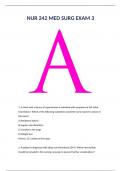Exam (elaborations)
NUR 242 MED SURG EXAM 3 LATEST ACTUAL EXAM 2000 QUESTIONS AND CORRECT DETAILED ANSWERS ALREADY GRADED A+||GALEN COLLEGE OF NURSING
- Course
- Institution
NUR 242 MED SURG EXAM 3 LATEST ACTUAL EXAM 2000 QUESTIONS AND CORRECT DETAILED ANSWERS ALREADY GRADED A+||GALEN COLLEGE OF NURSING
[Show more]




